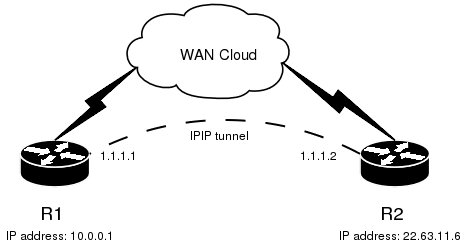IP over IP (IPIP) Tunnel Interface
Document revision 1.3 (09-May-2003)
This document applies to the MikroTik RouterOS V2.7
The IPIP tunneling implementation on the MikroTik RouterOS is RFC 2003 compliant.
IPIP tunnel is a simple protocol that encapsulates IP packets in IP to make a tunnel
between two routers. The IPIP tunnel interface appears as an interface under the interface list.
Many routers, including Cisco and Linux based, support this protocol.
This protocol makes multiple network schemes possible.
IPIP tunneling protocol adds the following possibilities to a network setups:
- to tunnel Intranets over the Internet
- to use it instead of using source routing
Packages required : None
License required : Any
Home menu level : /interface ipip
Standards and Technologies : IPIP (
RFC2003)
Hardware usage : not significant
Software
Package Installation and Upgrading
Device Driver Management
IP Addresses and Address Resolution Protocol (ARP)
Log Management
Submenu level : /interface ipip
An IPIP interface should be configured on two routers that have the possibility
for an IP level connection and are RFC 2003 compliant. The IPIP tunnel may run
over any connection that transports IP. Each IPIP tunnel interface can connect
with one remote router that has a corresponding interface configured.
An unlimited number of IPIP tunnels may be added to the router.
For more details on IPIP tunnels, see RFC 2003.
name (name; default: ipipN) - interface name for reference
mtu (integer; default: 1480) - Maximum Transmission Unit. Should be set to 1480 bytes to avoid
fragmentation of packets. May be set to 1500 bytes if mtu path discovery
is not working properly on links.
local-address (IP address) - Local address on router which sends IPIP traffic to the remote side.
remote-address (IP address) - The IP address of the other side of the IPIP tunnel -
may be any RFC 2003 compliant router.
Use /ip address add command to assign an IP address to the IPIP interface.
There is no authentication or 'state' for this interface.
The bandwidth usage of the interface may be monitored with the monitor
feature from the interface menu.
MikroTik RouterOS IPIP implementation has been tested with Cisco 1005.
The sample of the Cisco 1005 configuration is given below:
interface Tunnel0
ip address 10.3.0.1 255.255.255.0
tunnel source 10.0.0.171
tunnel destination 10.0.0.204
tunnel mode ipip
Suppose we want to add an IPIP tunnel between routers R1 and R2:

First we need to configure IPIP interfaces and then add IP addresses to them.
The configuration for router R1 is as follows:
[admin@MikroTik] interface ipip> add
local-address: 10.0.0.1
remote-address: 22.63.11.6
[admin@MikroTik] interface ipip> print
Flags: X - disabled, R - running
# NAME MTU LOCAL-ADDRESS REMOTE-ADDRESS
0 X ipip1 1480 10.0.0.1 22.63.11.6
[admin@MikroTik] interface ipip> en 0
[admin@MikroTik] interface ipip> /ip address add address 1.1.1.1/24 interface=ipip1
The configuration of the R2 is shown below:
[admin@MikroTik] interface ipip> add local-address=22.63.11.6 remote-address=10.
0.0.1
[admin@MikroTik] interface ipip> print
Flags: X - disabled, R - running
# NAME MTU LOCAL-ADDRESS REMOTE-ADDRESS
0 X ipip1 1480 22.63.11.6 10.0.0.1
[admin@MikroTik] interface ipip> enable 0
[admin@MikroTik] interface ipip> /ip address add address 1.1.1.2/24 interface=ipip1
Now both routers can ping each other:
[admin@MikroTik] interface ipip> /ping 1.1.1.2
1.1.1.2 64 byte ping: ttl=64 time=24 ms
1.1.1.2 64 byte ping: ttl=64 time=19 ms
1.1.1.2 64 byte ping: ttl=64 time=20 ms
3 packets transmitted, 3 packets received, 0% packet loss
round-trip min/avg/max = 19/21.0/24 ms
[admin@MikroTik] interface ipip>
Links for IPIP documentation:
http://www.ietf.org/rfc/rfc1853.txt?number=1853
http://www.ietf.org/rfc/rfc2003.txt?number=2003
http://www.ietf.org/rfc/rfc1241.txt?number=1241
© Copyright 1999-2003, MikroTik

